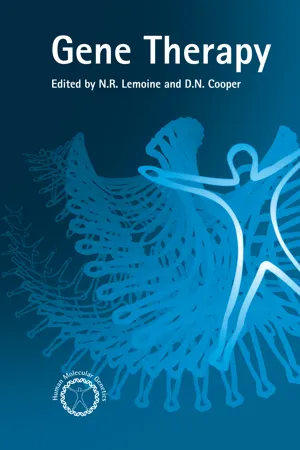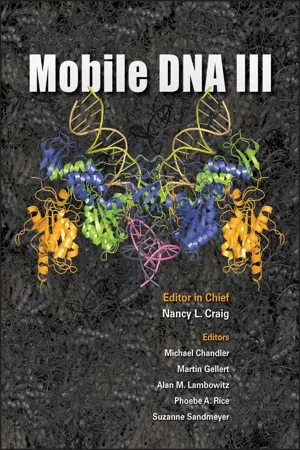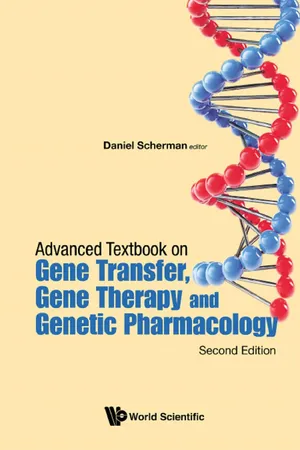Biological Sciences
Adeno Associated Virus Vector
Adeno-associated virus (AAV) vector is a small, non-pathogenic virus commonly used as a delivery system for gene therapy. It is capable of infecting both dividing and non-dividing cells, making it a valuable tool for introducing therapeutic genes into target cells. AAV vectors have shown promise in treating a wide range of genetic disorders and have become a popular choice for gene therapy applications.
Written by Perlego with AI-assistance
Related key terms
5 Key excerpts on "Adeno Associated Virus Vector"
- eBook - ePub
- David Cooper, Prof Nick Lemoine, David Cooper, Prof Nick Lemoine(Authors)
- 2020(Publication Date)
- Garland Science(Publisher)
5Adeno-associated virus vectors for human gene therapy
Jeffrey S. Bartlett and Richard J. Samulski5.1 Introduction
Presently, human gene therapy is limited by the efficiency of stable gene transfer. To overcome this obstacle, adeno-associated virus (AAV) is being developed as a vector. This unique member of the parvovirus family possesses several properties which distinguish it from other gene transfer vectors. Its advantages include stable and efficient integration of viral DNA into the host genome (Berns et al., 1975; Cheung et al., 1980; Hoggan et al., 1972; Laughlin et al., 1986; McLaughlin et al., 1988), lack of any associated human disease (Berns et al., 1982), broad host range (Buller et al., 1979; Casto et al., 1967), the ability to infect growth-arrested cells (Wong et al., 1993), and the ability to carry non-viral regulatory sequences without interference from the viral genome (Miller et al., 1993a; Walsh et al., 1992). In addition, there has been no superinfection immunity associated with AAV vectors (Lebkowski et al., 1988; McLaughlin et al., 1988).AAV is a defective virus with a unique bi-phasic life cycle. It can be propagated either as a lytic virus or maintained as a provirus integrated into the host cell genome (Atchison et al., 1965; Hoggan et al., 1966, 1972) (Figure 5.1 ). In a lytic infection, replication requires co-infection with either adenovirus (Atchison et al., 1965; Hoggan et al., 1966; Melnick et al., 1965), or herpes simplex virus (HSV) (Buller et al., 1981; McPherson et al., 1985); hence the classification of AAV as a ‘defective’ virus. Vaccinia virus can also provide at least partial helper function (Schlehofer et al., 1986). When AAV infects tissue culture cells in the absence of helper virus, it establishes latency by persisting in the host cell genome as an integrated provirus (Berns et al., 1975; Cheung et al., 1980; Handa et al., 1977; Hoggan et al., 1972). Although AAV physically recombines its DNA into the host cell genome, it can be rescued from the chromosome and re-enter the lytic cycle if these cells are superinfected with helper virus. The lytic phase of the AAV life cycle requires the expression of the adenovirus early gene products (Richardson and Westphal, 1981) Ela (Chang et al., 1989; Richardson and Westphal, 1984), Elb (Richardson and Westphal, 1984; Samulski et al., 1988), E2a (Jay et al., 1979), E4 (Carter et al., 1983; Laughlin et al., 1982; Richardson and Westphal, 1981, 1984), and VA RNA (Janik et al., 1989; West et al., - eBook - ePub
The World Scientific Encyclopedia of Nanomedicine and Bioengineering I
Nanotechnology for Translational Medicine: Tissue Engineering, Biological Sensing, Medical Imaging, and Therapeutics(A 4-Volume Set)
- Yu Cheng, Jia Huang, Yarong Liu, Pin Wang, Bingbo Zhang(Authors)
- 2016(Publication Date)
- WSPC(Publisher)
1 Gene therapy, which is the delivery of genetic material into cells for expression of specific genes, has shown success in a number of monogenic and complex genetic disorders. Gene delivery vehicles used for therapeutic applications can be divided into two classes: viral and nonviral vectors. A major focus of current gene therapy involves disabling the pathological effects of viral vectors. Although they are challenged by the pre-existing immunity of their hosts, viral vectors maintain an advantage over nonviral vectors due to their established gene delivery mechanisms. Common viral vectors that have been studied for potential clinical applications include retroviral vectors, lentiviral vectors, adenoviral vectors and adeno-associated virus (AAV) vectors, which is the focus of this chapter.AAV vectors have gained popularity for gene therapy applications mainly because of their nonpathogenicity and ability to deliver genes to a site-specific location in the host chromosome. Moreover, AAVs have a native tropism to a number of clinically relevant tissues such as the liver, muscles and neuronal tissues, which makes it a promising gene delivery vehicle for therapeutic gene therapy. However, the progress of AAV engineering has been hindered by problems concerning its broad native tropism, pre-existing host immunity and impaired intracellular trafficking. Since the viral capsid protein is the major contributor to these processes, multiple studies have focused on developing strategies to chemically or genetically modify the capsid surface to overcome the systemic challenges. This chapter addresses the various capsid modification strategies adopted for AAV engineering to enhance targeting and transduction efficiency.2.AAV Serotypes
The AAV is a parvovirus initially discovered as a contaminant in simian adenoviral type 15 (SV15) preparations. Over a hundred AAV clones have since been detected in primate genomes. The small, DNA containing particles were first observed in a pooled harvest of rhesus-monkey-kidney-cell (RMK) cultures infected with SV15. Experiments showed that AAV could only replicate in RMK cultures when it is coinfected with SV15, suggesting that AAV particles behave as defective viruses because they cannot replicate in the absence of adenoviruses (Ad).2 Five primate AAVs, which include AAV1–6 except for AAV5, were found as contaminants in preparations of adenovirus.3 In order to isolate new serotypes, laboratories used polymerase chain reaction (PCR) to isolate AAV7–11 and many other clones from human and nonhuman primate genomes.4 −6 - eBook - ePub
- Michael Chandler, Martin Gellert, Alan M. Lambowitz, Phoeba A. Rice, Suzanne B. Sandmeyer(Authors)
- 2015(Publication Date)
- ASM Press(Publisher)
Curr Top Microbiol Immunol 158: 97–129.[PubMed] [CrossRef]19. Buller RM, Rose JA. 1978. Characterization of adenovirus-associated virus-induced polypeptides in KB cells. J Virol 25: 331–338.[PubMed]20. Wistuba A, Kern A, Weger S, Grimm D, Kleinschmidt JA. 1997. Subcellular compartmentalization of adeno-associated virus type 2 assembly. J Virol 71: 1341–1352.[PubMed]21. Rolling F, Samulski RJ. 1995. AAV as a viral vector for human gene therapy. Generation of recombinant virus. Mol Biotechnol 3: 9–15.[PubMed] [CrossRef]22. Warrington KH, Gorbatyuk OS, Harrison JK, Opie SR, Zolotukhin S, Muzyczka N. 2004. Adeno-associated virus type 2 VP2 capsid protein is nonessential and can tolerate large peptide insertions at its N terminus. J Virol 78: 6595–6609.[PubMed] [CrossRef]23. Gao G, Vandenberghe LH, Wilson JM. 2005. New recombinant serotypes of AAV vectors. Curr Gene Ther 5: 285–297.[PubMed] [CrossRef]24. Xie Q, Bu W, Bhatia S, Hare J, Somasundaram T, Azzi A, Chapman MS. 2002. The atomic structure of adeno-associated virus (AAV-2), a vector for human gene therapy. Proc Natl Acad Sci USA 99: 10405–10410.[PubMed] [CrossRef]25. DiMattia M, Govindasamy L, Levy HC, Gurda-Whitaker B, Kalina A, Kohlbrenner E, Chiorini JA, McKenna R, Muzyczka N, Zolotukhin S, Agbandje-McKenna M. 2005. Production, purification, crystallization and preliminary X-ray structural studies of adeno-associated virus serotype 5. Acta Crystallogr Sect F Struct Biol Cryst Commun 61: 917–921.[PubMed] [CrossRef]26. Xie Q, Ongley HM, Hare J, Chapman MS. 2008. Crystallization and preliminary X-ray structural studies of adeno-associated virus serotype 6. Acta Crystallogr Sect F Struct Biol Cryst Commun 64: 1074–1078.[PubMed] [CrossRef]27. Padron E, Bowman V, Kaludov N, Govindasamy L, Levy H, Nick P, McKenna R, Muzyczka N, Chiorini JA, Baker TS, Agbandje-McKenna M. 2005. Structure of adeno-associated virus type 4. J Virol 79: 5047–5058.[PubMed] [CrossRef] - eBook - ePub
Advanced Textbook on Gene Transfer, Gene Therapy and Genetic Pharmacology
Principles, Delivery and Pharmacological and Biomedical Applications of Nucleotide-Based Therapies
- Daniel Scherman(Author)
- 2019(Publication Date)
- WSPC (EUROPE)(Publisher)
5, e1000340.Ayuso, E., Mingozzi, F., Bosch, F. (2010). Production, purification and characterization of adeno-associated vectors, Curr Gene Ther, 10, 423–436.Bell, C.L., Vandenberghe, L.H., Bell, P., et al. (2011). The AAV9 receptor and its modification to improve in vivo lung gene transfer in mice, J Clin Invest, 121, 2427–2435.Büning, H., Perabo, L., Coutelle, O., et al. (2008). Recent developments in adeno-associated virus vector technology, J Gene Med, 10, 717–733.Daya, S., Berns, K.I. (2008). Gene therapy using adeno-associated virus vectors, Clin Microbiol Rev, 21, 583–593.Duan, D., Sharma, P., Dudus, L. et al. (1999). Formation of adeno-associated virus circular genomes is differentially regulated by adenovirus E4 ORF6 and E2a gene expression, J Virol, 73, 161–169.Duan, D., Sharma, P., Yang, J. et al. (1998). Circular intermediates of recombinant adeno-associated virus have defined structural characteristics responsible for long-term episomal persistence in muscle tissue, J Virol, 72, 8568–8577.Flotte, T.R., Berns, K.I. (2005). Adeno-associated virus, a ubiquitous commensal of mammals, Hum Gene Ther, 16, 401–407.Gao, G., Alvira, M.R., Somanathan, S., et al. (2003). Adeno-associated viruses undergo substantial evolution in primates during natural infection, Proc Natl Acad Sci USA, 100, 6081–6086.Gao, G., Alvira, M.R., Wang, L., et al. (2002). Novel adeno-associated viruses from rhesus monkeys as vectors for human gene therapy, Proc Natl Acad Sci USA, 99, 11854–11859.Gao, G., Vandenberghe, L.H., Alvira, M.R., et al. (2004). Clades of adeno-associated viruses are widely disseminated in human tissues, J Virol, 78, 6381–6388.Gaudet, D., de Wal, J., Tremblay, K., et al. (2010). Review of the clinical development of alipogene tiparvovec gene therapy for lipoprotein lipase deficiency, Atheroscler Suppl, 11 - eBook - ePub
Advanced Textbook on Gene Transfer, Gene Therapy and Genetic Pharmacology
Principles, Delivery and Pharmacological and Biomedical Applications of Nucleotide-Based Therapies
- Daniel Scherman(Author)
- 2013(Publication Date)
- ICP(Publisher)
in vivo gene transfer.A further limitation concerns the high doses of vector that have to be administered to achieve a therapeutic effect. Indeed, doses of approximately 1012 vector particles per kg were required in the initial hemophilia B trials using rAAV2 vectors. Even if lower doses were used in the later AAV8 trials, the amount of particles delivered as a single injection in patients still remains impressively high. This is also the case for subretinal injection if one considers that the vector particles remains sequestered in a very small zone of the retina. Besides the challenge of producing high particle numbers, application of high vector doses increases the risk of inducing immune responses and of off-target transduction. Hence, efforts are focused on improving transduction efficiencies by identifying barriers to AAV transduction followed by introduction of specific modifications. Successful examples are the development of self-complementary vector genomes (see above), mutation of exposed tyrosine residues on the capsid surface to avoid capsid degradation and introduction of peptide ligands (cell-surface targeting) to enable transduction of cell types that lack AAV receptors.All the efforts discussed above will likely result in a considerable refinement of the AAV vector tool and in the precise identification of the most suitable conditions to achieve efficient gene transfer and a successful therapeutic outcome.ReferencesAlazard-Dany, N., Nicolas, A., Ploquin, A., et al. (2009). Definition of herpes simplex virus type 1 helper activities for adeno-associated virus early replication events, PLoS Pathog, 5, e1000340.Ayuso, E., Mingozzi, F., Bosch, F. (2010). Production, purification and characterization of adeno-associated vectors, Curr Gene Ther, 10, 423–436.Bell, C.L., Vandenberghe, L.H., Bell, P., et al. (2011). The AAV9 receptor and its modification to improve in vivo lung gene transfer in mice, J Clin Invest, 121
Learn about this page
Index pages curate the most relevant extracts from our library of academic textbooks. They’ve been created using an in-house natural language model (NLM), each adding context and meaning to key research topics.




